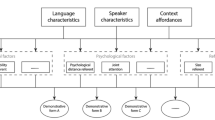Abstract
According to the Clark & Wilkes-Gibbs' collaborative model of reference, the repetition of a referential communication task produces changes in the making of references (decreasing number of words and of turns with the passing trials, increasing number of definite references and of labels), and these changes are interpreted as revealing the outgrowth of a collaborative process aiming at mutual understanding at the lowest cost. Using a repeated referential paradigm but without any physically present interlocutor, the present study aimed at answering the question of whether these changes are attributable to the mere repetition of the referential task. In adifferent addressee (DA) condition, the subjects were told before each new trial that what they would say would be presented later to another person; in asame addressee 9SA) condition, the subjects were told before each new trial that what they would say would be presented to the same person. With the passing trials, the subjects in the DA condition produced more and more words, but did not use any definite references or labels: These observations have no common point with the ones obtained within a conversational framework. The data obtained from speakers in the SA condition were only slightly different and far from being close to the ones gained in referential dialogues: The number of words remains constant, there was only a slight increase of definite references, and there were no labels. Repetition itself clearly cannot account for the changes in referring that have been reported in recent studies of how subjects cooperate in the making of references.
Similar content being viewed by others
References
Beaudichon, J. (1985). Que mesure-t-on dans les expériences consacrées au développement de la communication référentielle? In G. Noizet, D. Belanger and F. Bresson (Eds.),La communication. Paris: PUF.
Clark, H H., & Schaefer, E. F. (1987). Collaborating on contributions to conversations.Language and Cognitive Processes, 2 (1), 19–41.
Clark, H. H., & Wilkes-Gibbs, D. (1986). Referring as a collaborative process.Cognition, 22, 1–39.
Dickson, W. P. (1981).Children's oral communication skills. New York: Academic Press.
Foster, S. H. (1989).The communicative cometence of young children: A modular approach. New York: Longman.
Fusell, S. R., & Krauss, R. M. (1989). The effects of intended audience on message production and comprehension: Reference in a common ground framework.Journal of Experimental Social Psychology, 25, 203–219.
Glucksberg, S., Krauss, R. M., & Weisberg, R. (1966). Referential communication in nursery school children: Method and some preliminary findings.Journal of Experimental Child Psychology, 3, 333–342.
Glucksberg, S., Krauss, R. M., & Higgins, E. T. (1975). The development of referential communication skills. In F. D. Horowitz (Ed.),Review of child development research (Vol. 4), Chicago: University of Chicago Press.
Hupet, M., Seron, X., & Chantraine, Y. (1991). The effects of codability and discriminability of the referents on the collaborative referring procedure.British Journal of Psychology, 82, 449–462.
Isaacs, E. A., & Clark, H. H. (1987). References in conversation between experts and novices.Journal of Experimental Psychology: General, 116 (1), 26–37.
Krauss, R. M., & Weinheimer, S. (1966). Concurrent feedback, confirmation and the encoding of referents in verbal communication.Journal of Personality and Social Psychology, 4 (3), 343–346.
Krauss, R. M., & Weinheimer, S. (1967). Effect of referent similarity and communication mode on verbal encoding.Journal of Verbal Learning and Verbal Behavior, 6, 359–363.
McTear, M. (1985).Children's conversation. Oxford, England: Basil Blackwell.
Rosenberg, S., & Cohen, B. D. (1966). Referential processes of speakers and listeners.Psychological Review, 73 (3), 208–231.
Scarpa, E. M. (1990). Intonation and dialogue processes in early speech. In G. Conti-Ramsden & C. Snow (Eds.),Children's language (Vol. 7). Hillsdale, NJ: Erlbaum.
Schober, M. F., & Clark, H. H. (1989). Understanding by addressees and overhearers.Cognitive Psychology, 21, 211–232.
Taylor, T. J., & Cameron, D. (1987).Analysing conversation: Rules and units in the structure of talk. Oxford, England: Pergamon Press.
Wardhough, R. (1987).How conversation works? Oxford, England: Basil Blackwell.
Author information
Authors and Affiliations
Additional information
This research was partly supported by a project grant from the National Fund for Scientific Research (Belgium) to Y. Chantraine, research assistant at the University of Louvain in Belgium.
Rights and permissions
About this article
Cite this article
Hupet, M., Chantraine, Y. Changes in repeated references: Collaboration or repetition effects?. J Psycholinguist Res 21, 485–496 (1992). https://doi.org/10.1007/BF01067526
Issue Date:
DOI: https://doi.org/10.1007/BF01067526




